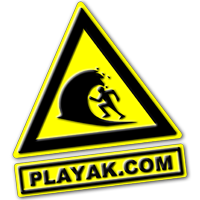Here's an article I wrote on Kayak surfing it may help:
Ocean surfing is exhilarating. The size of the surf can be many times greater than that a river wave. The vast expanse of the horizon gives a sense of a global scale. One may realize that this energy has traveled hundreds of miles. To many, this is the stuff dreams are made of.
Get The BIG Picture:
Before getting in the ocean, take a few minutes and observe. Is the tide coming in or going out? Are there rocks or reefs that pose a hazard? Can you safely handle the size of the surf? Are there any watercrafts that may pose a threat to your safety?
Getting Past The Breaks:
Timing is critical when attempting to get out past the big breaks. Typically, waves come in sets, get out between them. The wall of foam created from a wave that has crashed can be a formidable opponent. If a wave has already crashed and a foam pile is coming, you MUST get the nose above the foam-pile. Rock the bow up and pull on your knees just before the foam pile hits. As soon as the nose is on the foam pile, slam the bow back down and paddle hard. The motion of throwing the bow back down acts like an ollie, bringing your weight back over the boat and the tail up to the surface. This should help keep you from getting stuck in a backward-surf. So to recap, clear the nose, slam it down, and paddle hard.
Catching Waves:
Okay so one quick thing about catching a wave; as the wave comes under you, paddle hard and put your boat on edge. Get on a rail and paddle until you have gained some momentum. You will be able to catch waves more easily as you are putting your boat on a track. You should also be heading slightly right or left on the wave. This exposes more of the surface area of the boat to the wave and may help give you some added forward momentum.
So Now You're On The Wave:
It's important that you DON'T just look straight ahead as you surf your wave. Turn your head and notice where you are in relationship to the wave, next choose where you want to go. Lead with your head. Be decisive and look at where you want to be not where you are going. Some paddlers complain that their bow dives under as they surf down the wave. If this is the case, lean back and travel in diagonal paths so the bow does not bottom out in the trough of the wave. Cutting back and forth also helps pull you higher on the wave as you expose more surface area to the oncoming current.
Quick Tip:
When trying to turn on a wave use a combination of forward sweep strokes and stern rudders on the opposite side. If you only rudder you will not have the momentum to drop you into your next turn (kind of like planting your ski pole ahead of your turn). Ruddering alone, works well to pull you up the waveface. Forward sweep strokes alone, work well to help you fall down the wave faster.
Last But Not Least:
If you capsize try to go with it and roll up the other side. If you miss your first roll, wait a few second for the water to settle down a bit before you try again. Stay relaxed, composed, and confident; two things you won't have to worry about are strainers, and keepers. It can be a bit difficult to roll in a foam pile because of turbulence and foam. Foam is less dense than green water. Therefore, it becomes harder to catch tension with the paddle blade. Waiting for the foam to settle can help give you the support you need. If your Eskimo Roll still fails remember to keep your head down and hip snap!
I hope this helps.
Saddle-Up,
Boe




